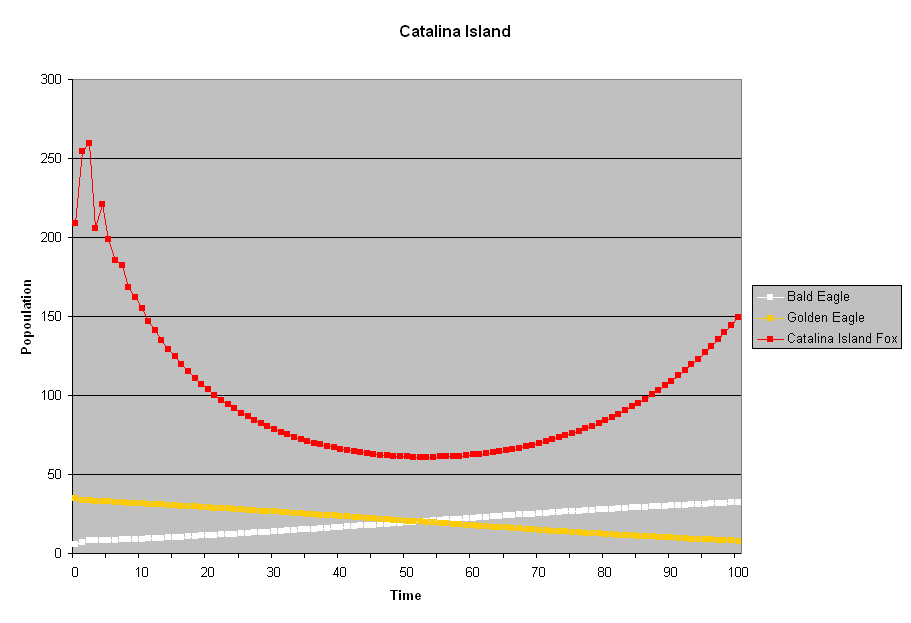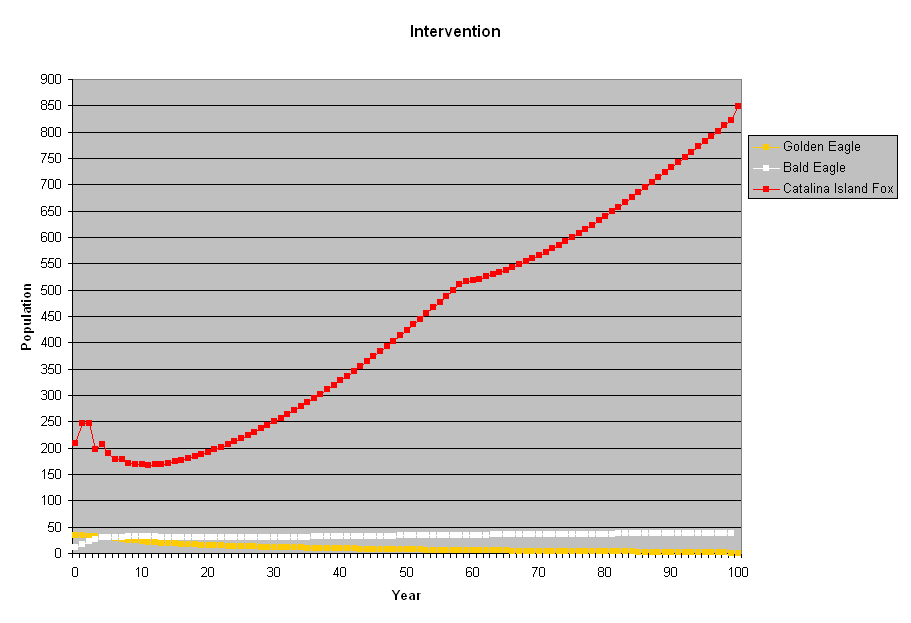


Human Intervention to Preserve the Catalina Island Fox
An interspecies relationship between the Golden Eagle, Bald Eagle, and Catalina Island Fox
My next study focused on the population of the Santa Catalina Island Fox. This sub species of the Island fox is endemic to Santa Catalina Island. This native species is at risk of becoming extinct, largely because of the explosion of the Golden Eagle population on the island. Catalina Island historically did not have a Golden Eagle population because the Island is the historic home to the Blad Eagle, which is very territorial and does not allow Golden Eagles to intrude. Due to the introduction to DDT on the island causing the Bald Eagle to become extinct, combined with the habitat destruction of Golden Eagles on mainland California, the Golden Eagles found their way to the island and not only found suitable nesting sites (the same ones used by the bald eagle), but also an abundance of prey, including the Island Fox. Due to the domestic pig being released on the island in previous centuries, there was an abundance of piglets as prey, causing an additional increase of the Golden Eagles on the island, and hyperpredation of the Island Fox began. Because the Bald Eagle only preys on oceanlife, and the Island Fox was only used to having the Blad Eagle cohabitating, it does not have the surviving skills necessary to survive a bird of prey like the Golden Eagle.
In order to combat this hyperpredation of the Island Fox, last year (2006) the Bald Eagle was reintroduced onto the island. What my models demonstrate is how this population will aide in the recovery of the Catalina Island Fox, and how continued intervention by man can speed up this recovery process.
I established a combination of concepts to achieve this model, including competition between the Golden Eagle, and the Bald Eagle, an amensalism relationship where the Island Fox population is dependent upon the Golden Eagle population, and an intervention model where additional individuals are released into the wild by man from a breeding program.

200 year Golden Eagle dominate competition

100 year, extinction of the Island Fox

200 year, extinction of the Island Fox
The above graphs demonstrate what happens if the growth rate of the Golden Eagles exceeds that of the Bald Eagles. In this example the competition will go to the Golden Eagles because they are out producing the Bald Eagle and winning out on the competition for nest sites. This results in the Golden Eagles reaching the carrying capacity of forty eagles on the Island, and stamping out the Bald Eagle population. This also results in the hyperpredation of the Island Fox and eventually the Catalina Island Fox's extinction.

200 year Bald Eagle dominate competition

100 year, extinction of the Golden Eagle

200 year, extinction of the Golden Eagle

400 year, extinction of the Golden Eagle
The above graphs demonstrate what happens if the growth rate of the Bald Eagles exceeds that of the Golden Eagles. This results in the Bald Eagles reaching the carrying capacity of forty eagles on the Island, and stamping out the Golden Eagle population. This is even if the Bald Eagle initial population is considerably smaller than that of the Godlen Eagle. If the Bald Eagles growth rate is higher, than they will still overrun the Golden Eagles. This will then also result in the Catalina Island Fox recovering from it's near extinction and returning to the carrying capacity of 1544 foxes. This doesn't happen before the fox population reaches a dangerous low, due to there still being Golden Eagles on the island, albeit a declining population. In this model they decline to only about 40 foxes before recovering and accelerating their population to their carrying capacity.
The above graphs show the results of human intervention, and how it may effect the eagle populations and fox population. This intervention is under the condition that two adult and two sub-adult bald eagles are introduced every year until the bald eagle population reaches 35 eagles, and the fox population is increased by an additional six yearling foxes each year until their population reaches 500. This results in a faster increase for the Bald Eagle, a faster decrease for the Golden Eagle, and therefore a quicker recoverey for the Catalina Island Fox.
Multiple Species Relationship Spreadsheet
Human Intervention Spreadsheet
Click on image to enlarge:



























